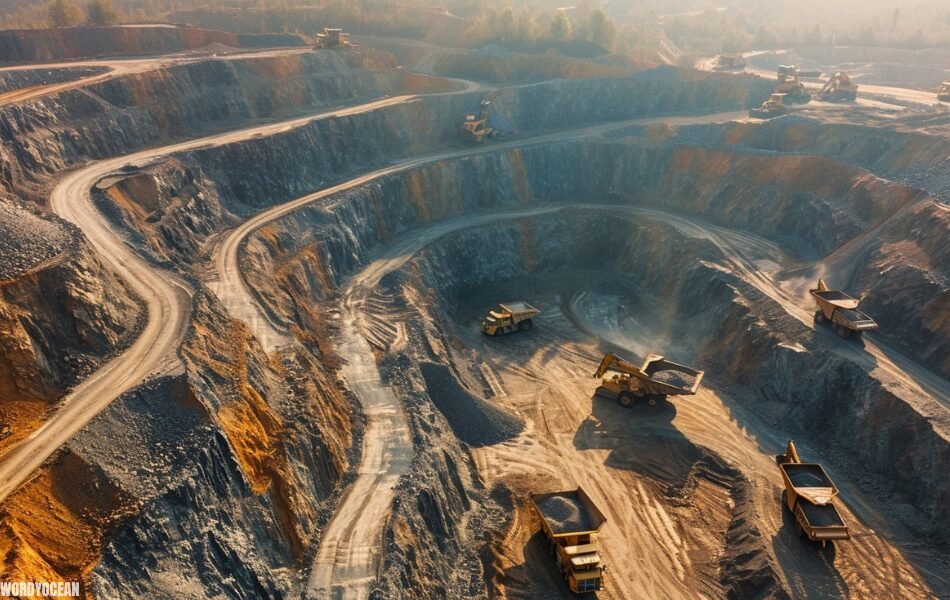Del Bandito Mine Esmeralda NV History: Legendary Boom

The Del Bandito Mine, nestled in the rugged terrain of Esmeralda County, Nevada, is a testament to the state’s rich mining history. Its story is one of discovery, boom, and eventual decline, reflecting the cyclical nature of the mining industry.
Discovered in the late 19th century Del Bandito Mine Esmeralda NV History quickly gained notoriety for its substantial silver and gold deposits. The allure of these precious metals attracted a wave of prospectors and miners, eager to strike it rich. The mine’s strategic location, coupled with technological advancements of the time, made it a lucrative venture.
During its heyday, the Del Bandito Mine was a bustling hub of activity. The surrounding town, once a mere speck on the map, experienced rapid growth as miners, merchants, and service providers flocked to the area. The mine’s economic impact extended far beyond the local community, contributing to Nevada’s overall prosperity
The Discovery of the Del Bandito Mine
The exact origins of the Del Bandito Mine’s discovery remain somewhat shrouded in the mists of time. However, it is widely believed that the mine was first unearthed in the late 19th century by intrepid prospectors drawn to the mineral-rich landscape of Esmeralda County. These early pioneers, armed with little more than picks, shovels, and unwavering determination, recognized the potential of the site. The presence of exposed mineral veins, particularly those rich in silver and gold, provided the initial clues to the vast treasure that lay beneath the surface.
The early days of mining at the Del Bandito Mine were marked by arduous labor and primitive techniques. Miners toiled tirelessly, extracting ore from deep underground. The harsh conditions, coupled with the dangers inherent in mining, made it a perilous occupation. Despite these challenges, the allure of striking it rich motivated countless individuals to seek their fortune at the Del Bandito Mine.
Ownership of the mine changed hands several times over the years, as different companies and individuals sought to capitalize on its mineral wealth. However, the core operations and the arduous task of extracting precious metals remained largely unchanged for many decades.
Del Bandito Mine Esmeralda NV History: The Golden Age
The late 19th and early 20th centuries marked a golden age for the Del Bandito Mine. Several factors converged to fuel a mining boom of unprecedented proportions. Technological advancements, such as improved mining equipment and techniques, made it possible to extract ore more efficiently and economically. Additionally, the discovery of rich veins of silver and gold within the mine’s depths further ignited interest from investors and miners alike.
The economic impact of the boom was profound, transforming the local community into a thriving mining town. As more miners flocked to the area, demand for housing, food, and other goods and services surged. Businesses sprang up to cater to the needs of the burgeoning population, and the local economy flourished. The Del Bandito Mine became the lifeblood of the region, providing employment opportunities and generating wealth.
While the boom years were a period of prosperity, they were not without their challenges. Labor disputes and accidents were not uncommon in the mining industry, and the Del Bandito Mine was no exception. The harsh working conditions, coupled with the inherent dangers of underground mining, took a toll on the health and safety of the miners. Despite these setbacks, the allure of riches continued to draw people to the mine, fueling its growth and significance.
A number of prominent figures played pivotal roles in the history of the Del Bandito Mine. These individuals, ranging from mine owners and engineers to labor leaders and local entrepreneurs, shaped the course of the mine’s development. Their stories, often intertwined with the broader narrative of the American West, offer valuable insights into the challenges and triumphs of the era
Del Bandito Mine Esmeralda NV History: The Future
As the 20th century progressed, the Del Bandito Mine began to experience a gradual decline. Several factors contributed to this downturn. The most significant was the depletion of high-grade ore reserves. As miners extracted more and more ore, the quality and quantity of the remaining deposits diminished. This made it increasingly difficult to maintain profitable operations.
Economic downturns, both nationally and internationally, also had a profound impact on the mine. During periods of economic recession, the demand for precious metals decreased, leading to lower prices and reduced profits. Additionally, technological advancements, while initially beneficial, eventually led to the development of more efficient mining methods that made the Del Bandito Mine less competitive.
Environmental regulations, which became more stringent over time, also played a role in the mine’s decline. These regulations imposed stricter standards on mining operations, requiring companies to invest in costly environmental protection measures. As the profitability of the mine dwindled, it became increasingly difficult to comply with these regulations.
The Del Bandito Mine eventually ceased operations in the mid-20th century. The closure of the mine had a devastating impact on the local community, which had long relied on it as a primary source of employment and income. The town that had once thrived as a mining center experienced a significant population decline, as many residents were forced to seek opportunities elsewhere. The mine’s closure marked the end of an era, leaving behind a legacy of both prosperity and hardship.
A Lasting Legacy
The Del Bandito Mine, though now a relic of the past, continues to cast a long shadow over the landscape of Esmeralda County. Its historical significance is undeniable, as it played a pivotal role in shaping Nevada’s mining heritage. The mine’s rich deposits of silver and gold attracted prospectors and miners from far and wide, contributing to the state’s economic growth and development.
The mine provided employment opportunities, stimulated economic activity, and fostered a sense of community among its residents. The town that grew up around the mine, once a bustling hub of activity, now stands as a reminder of its former glory.
While the mine’s active operations have ceased, its legacy lives on in various ways. The surrounding area still bears the scars of mining, with remnants of old structures and equipment scattered across the landscape. These physical traces serve as a tangible connection to the past and a reminder of the hard work and sacrifice of those who toiled in the mines.
The potential for future exploration or redevelopment of the Del Bandito Mine remains a topic of interest. While the most accessible and profitable deposits have long been extracted, there is still a possibility of discovering additional mineral resources at depth. However, any future mining activities would need to be conducted in a responsible and environmentally sustainable manner.
The environmental impact of mining is a complex issue, and the Del Bandito Mine is no exception.. In recent years, there has been a growing emphasis on mine reclamation and restoration. Efforts are being made to mitigate the environmental damage caused by past mining activities and to restore the affected lands to their natural state. By addressing these environmental concerns, it is possible to balance the economic benefits of mining with the need for environmental stewardship.
Conclusion
The Del Bandito Mine stands as a testament to the rich mining history of Nevada. Its discovery in the late 19th century sparked a mining boom that transformed the local landscape and economy. The mine’s substantial silver and gold deposits attracted prospectors and miners from far and wide, fueling its growth and prosperity. However, as the 20th century unfolded, the mine’s fortunes began to decline, leading to its eventual closure.
Despite its closure, the Del Bandito Mine continues to leave a lasting impact on the region. Its historical significance is undeniable, as it played a pivotal role in shaping Nevada’s mining heritage. The mine’s legacy can be seen in the local culture, economy, and the physical landscape.
As we reflect on the history of the Del Bandito Mine, it is important to recognize the challenges and triumphs of those who worked there. Their hard work and dedication helped to shape the American West.
To truly appreciate the significance of the Del Bandito Mine, we encourage readers to explore further. Visit the site, delve into local history books, or support organizations dedicated to preserving Nevada’s mining heritage. By doing so, we can ensure that the legacy of the Del Bandito Mine lives on for generations to come.
FAQs: Del Bandito Mine Esmeralda NV History
Q: What is the Del Bandito Mine?
A: The Del Bandito Mine is a historic silver and gold mine located in Esmeralda County, Nevada. It played a significant role in Nevada’s mining history, particularly during its boom years in the late 19th and early 20th centuries.
Q: When was the Del Bandito Mine discovered?
A: The exact date of the mine’s discovery is uncertain, but it is believed to have been discovered in the late 19th century.
Q: Who discovered the Del Bandito Mine?
A: The identity of the specific individual or group who discovered the Del Bandito Mine is not widely known. However, it was likely discovered by prospectors drawn to the mineral-rich landscape of Esmeralda County.
Q: What were the primary minerals mined at the Del Bandito Mine?
A: The primary minerals mined at the Del Bandito Mine were silver and gold.







